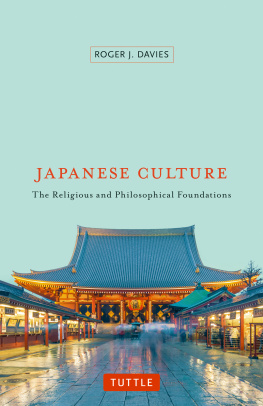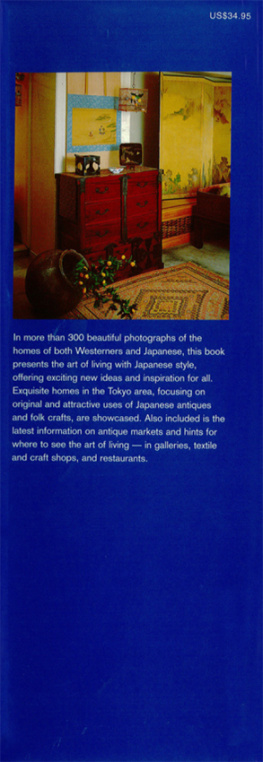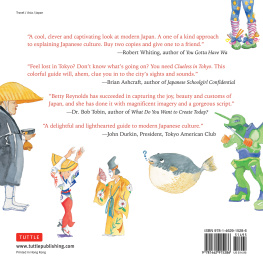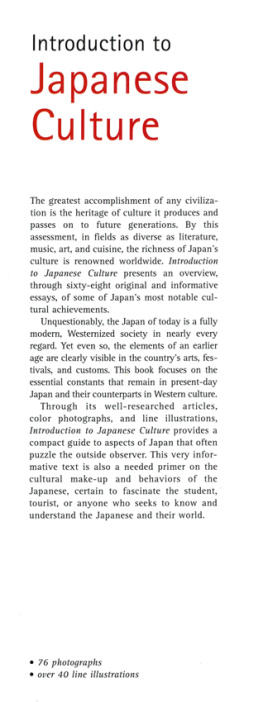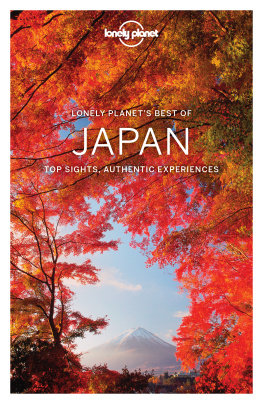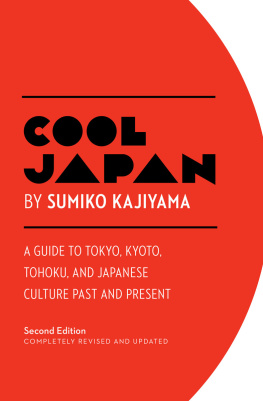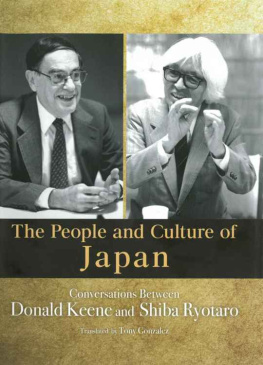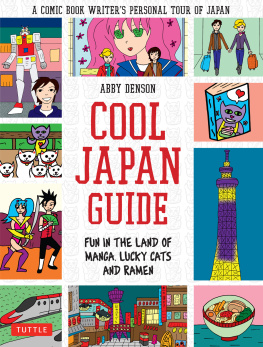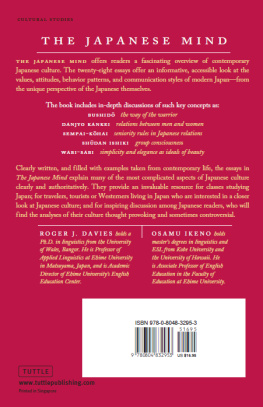UNDERSTAND
JAPAN IN 1 DAY
(Extensive Guide to Japan for the Busy People)
by
JK Styles
Bookbranchpublishing@gmail.com
This ebook is licensed for your personal enjoyment only. This ebook may not be re-sold or given away to other people. If you like to share this book with another person, please purchase an additional copy for each person you share it with.
Copyright 2015 Book Branch . All rights reserved. Including the right to reproduce this book or portions thereof, in any form. No part of this text may be reproduced in any form without the express written permission of the author.
Version 2016.11.02
Contents
Understand
Get in
Sleep
Welcome
Japans capital, Tokyo, is the most populated metropolitan area in the world with 38 million people. When I first arrived in Tokyo in the 2000s I traveled by local train from one side (East) to the other (West). With changes it took me nearly 3 hours! How many cities in the world does it take 4 hours to traverse by train? Bear in mind there were no delays.
Today, Japan thrives in both traditional and modern culture. The Japanese culture is strong, warm and interesting. Japan never fails to always me amaze me. Once you start your journey to understand more about Japan, you will want to constantly learn and know more.
Do you know?
# Japan Is Home to the Worlds Craziest Vending Machines
The Japanese people love vending machines. In fact, there are around 5.52 million of them scattered throughout the country. Over the years, these machines have greatly evolved from being practically convenient to extremely bizarre. In most countries, vending machines typically sell snacks like chips, gums, candies, sodas, and chocolates. However, the Japanese seemed to have combined the practicality of vending machines with their love for innovation and bizarre everything.
In Japan, its perfectly normal for vending machines to sell fresh eggs, bags of rice, and even fresh bouquets of flowers. If these arent enough to amuse you, they also sell toilet paper, condoms, umbrellas, fish baits, and even porn magazines. Crazy, yet oddly convenient.
# Eating Raw Horse Meat Is Perfectly Normal in Japan
Many of us would cringe at the thought of eating horse meat, especially if its raw and cold. But in Japan, raw horse meat, also called basashi, is considered a delicacy and is served in many restaurants. Eating raw horse meat is not a recent fad popularized by a celebrity or an innovative chef, though its been practiced by the Japanese for many decades now.
Before you dismiss the idea of trying basashi, know that its much healthier than pork and beef, and is less prone to E. coli contamination. It is very high in protein yet low in calories, and is rich in Linoleic Acid. Aside from that, eating horse meat may possibly prolong your life. A demographic statistics published in 2013 showed that the residents of the Nagano prefecture had the highest life expectancy in Japan: 80.88 years for men and 87.18 for women. Their secret: eating horse meat.
# Families in Japan Use the Same Water for Bathing
For the Japanese, taking a bath is not only about cleansing the body. Its also an effective way to relax the mind, the body, and the spirit. This is the reason why most Japanese take hot baths during the evening and go to hot springs or onsens regularly. Unlike in the Western world, Japanese families use the same water for bathing, and no they dont take baths simultaneously. The father goes first, followed by the mother, and then the children.
Almost all Japanese homes have bathtubs. However, they only use them for soaking and not for cleansing. In general, the Japanese clean, scrub, and soap their bodies outside the bathtubs with the use of a wash bowl. After they have cleaned and rinsed themselves thoroughly, theyll then enter the tub, soak their bodies, and enjoy the relaxation that the hot bath water brings. Since the cleansing is done outside the bathtubs, the hot water remains clean and clear, fit to be used by other family members. One interesting aspect of Japans unique way of bathing is that house guests are given the honor of using the hot bath water first.
# Slurping When Eating Soups or Noodles Is Perfectly Normal in Japan
In the Western world, people are expected to eat their food without making any unnecessary noises. Creating sounds like slurping when eating soups or noodles is considered inappropriate and rude. However, in Japanese society, it is the complete opposite. Slurping is perfectly normal and acceptable, even when done in public. In fact, slurping is highly encouraged.
So, why do the Japanese make pig-like sounds when eating hot soups and noodles? In Japan, slurping is considered as a sign of appreciation and approval. It means that you find the soup or noodles youre eating so delectable, you want to get it in your mouth as quickly as possible, and by any means necessary. In other words, slurping is a highly accepted way of complimenting the cook for doing a great job.
Are you ready to explore about Japan and its rich culture already?
Introduction
Japan, known as Nihon or Nippon () in Japanese, is an island nation in East Asia. Its insular character has allowed it to develop a very unique, intricate culture, while its closeness to other ancient Far Eastern cultures, in particular China, has left lasting influence. While forever a warring nation, both internally and over its seas, Japanese have always placed emphasis on inner balance, tranquility and natural beauty, which became increasingly important now that Japan grew to be one of world's most densely-populated countries, and its legendary work ethic makes life in its cities quite hectic.
Japan's sophisticated cuisine has made ways to all corners of the world by means of sushi (and the less-sophisticated instant ramen noodles), but it is only in the country when you can truly appreciate the true form of it. Even more fascinating is the country's popular culture, which has developed a fandom all over the world, in particular the manga comics and anime cartoons - with the Japanese taking their affinity to their favorite characters and themes to the extreme.
In the 20th century, Japan enjoyed impressive economic growth, putting it among the world's most affluent nations today. This was mostly driven by rapid modernization and specialization in high technology in particular. Due to that, Japan is now full of contrasts between the still alive tradition and much cherished heritage and the ultra-modern infrastructure, buildings and facilities. The country's numerous airports and the world-renowned shinkansen high-speed train system allow easy entry and convenient transport, and while the Japanese are known to be reserved and their language skills are not their strongest asset, they will go out of their way to make you feel a welcome visitor.
Regions
Hokkaido (Central Circuit, Eastern Circuit, Northern Circuit, Southern Circuit)
Northernmost island and snowy frontier. Famous for its wide open spaces and cold winters.
Tohoku (Aomori, Iwate, Akita, Miyagi, Yamagata, Fukushima)
Largely rural north-east part of the main island Honshu, best known for seafood, skiing and hot springs.
Kanto (Ibaraki, Tochigi, Gunma, Saitama, Chiba, Tokyo, Kanagawa)
Coastal plain of Honshu, includes the cities of Tokyo and Yokohama.
Chubu (Niigata, Toyama, Ishikawa, Fukui, Yamanashi, Nagano, Shizuoka, Aichi, Gifu)
Mountainous middle region of Honshu, dominated by the Japan Alps and Japan's fourth-largest city Nagoya.
Kansai (Shiga, Mie, Kyoto, Osaka, Nara, Wakayama, Hyogo)
Western region of Honshu, ancient capital of culture and commerce, including the cities of Osaka, Kyoto, Nara and Kobe.
Next page


